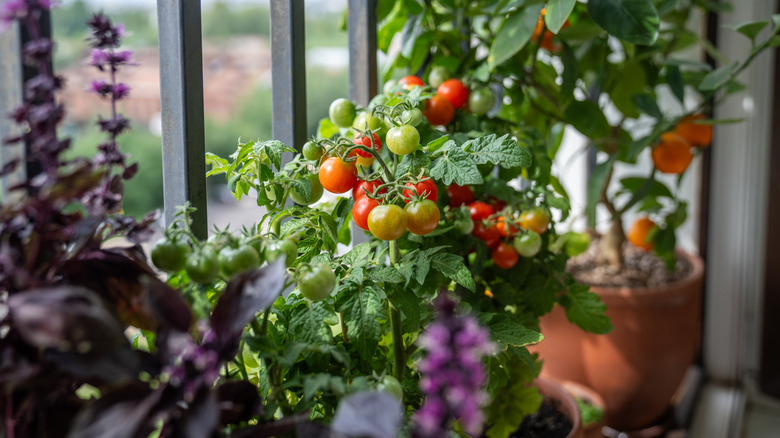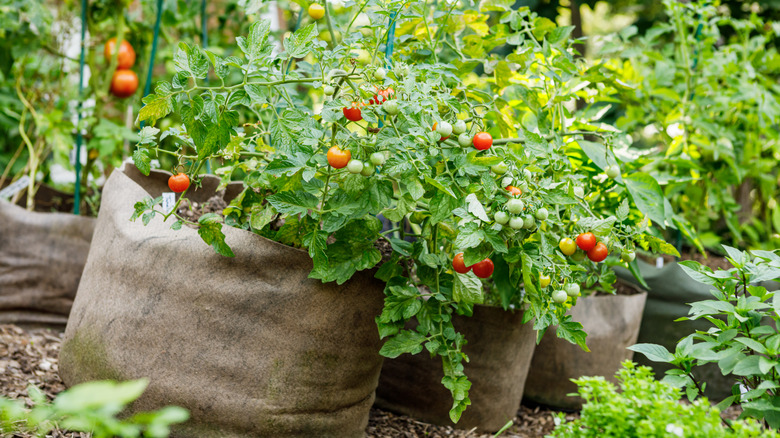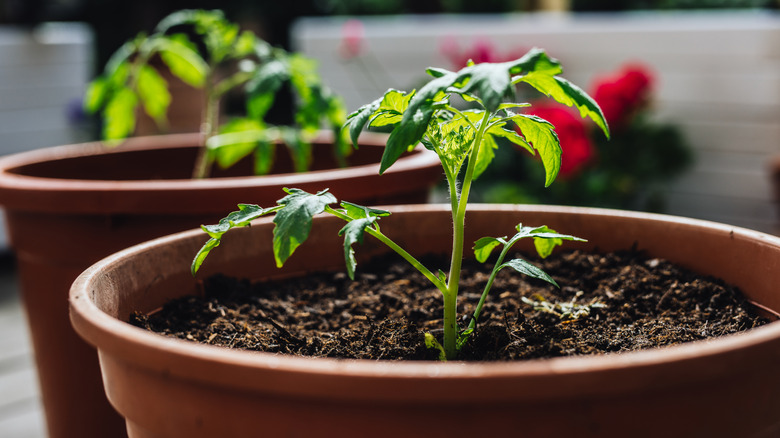Planting Tomatoes? What To Look For When Buying A Growing Container
What says summer more than a fresh, juicy tomato? Not much. So, it's no surprise that even people without big backyards are growing tomatoes in containers. However, choosing the right container could be the difference between a bountiful harvest and a total bust. Luckily, Tiffany Selvey, House Digest's Garden Editor and in-house Master Gardener, has some exclusive advice to help aspiring tomato growers pick the perfect container.
Selvey says, "There are two primary considerations for growing tomatoes in containers: Size and drainage." Generally, determinate varieties of tomatoes are your best option for growing in containers, but if you're going to grow an indeterminate variety — which keeps growing throughout the season — bigger is better. "Even standard determinate varieties need plenty of room for roots," she says, "so I recommend nothing smaller than 5 gallons to provide room for the plant to grow without getting root-bound."
With that said, Selvey explained that sometimes you can get away with a smaller container, "If you are growing specialty tomato varieties, like mini or dwarf species, you can grow them in smaller containers, but the rules for drainage are the same." In fact, drainage might be the most important consideration, outside of size, when picking a container. "All container plants need good drainage, but tomatoes are particularly prone to root rot in soggy soil," says Selvey. Therefore, if your container does not already have drainage holes, you will need to drill some.
Economical options for growing tomatoes in containers
Big containers can sometimes be expensive, and if you plan on growing multiple tomato plants, the costs can add up quickly. Luckily, Tiffany Selvey has some exclusive suggestions for House Digest's readers, "Large grow bags are probably the cheapest option, but 5-gallon buckets and mineral tubs with drainage holes drilled in the bottom are also excellent choices," she says. Mineral tubs, or 25-gallon grow bags, are the better option for those wanting to grow indeterminate varieties of tomatoes. Plus, as Selvey points out, these options also "leave room for the support these species need, like tomato cages."
However, not everyone wants buckets hanging around the garden all season long. If you're concerned about aesthetic appeal, Selvey explained that, "a standard large planter is a more attractive option," before adding that gardeners should, "look for a container that's at least 24 inches wide." Alternatively, you can also consider DIY projects that turn common household items into planters. You never know what might spark an idea for a practical but beautiful large container. And remember Selvey's advice, "If you aren't sure if a container is large enough, err on the side of caution and get one bigger."
Containers to avoid when growing tomatoes
In the internet age, there is no shortage of products claiming they can help you grow a bountiful harvest of tomatoes in surprising places. However, these products aren't always all they're cracked up to be. As Tiffany Selvey exclusively told House Digest, "There are products and DIY projects that promote growing tomatoes upside down." However, she added, "This is rarely a good idea because these containers are usually too small to hold much soil, leaving little room for roots." Plus, she told us how drainage and moisture is affected by these upside down methods, explaining that, "These containers also dry out very quickly."
Roots are mostly meant to grow in the ground, so if you're hoping for a big tomato harvest, it's essential to keep them down to earth, where they're supposed to be. With the right container in hand, all you need to do is keep an eye out for one of the biggest problems with container gardening – drying out — and get growing!


